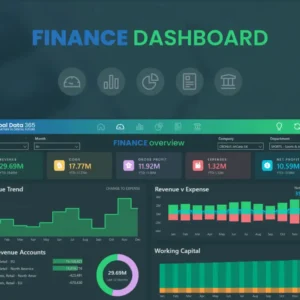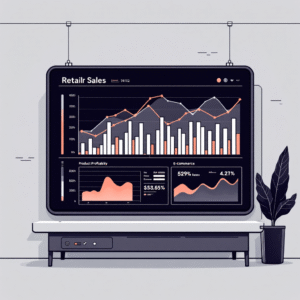Power BI Performance Best Practices
Complete Guide to Optimize Your Dashboards for Maximum Speed and Efficiency
📋 Table of Contents
🚀 Introduction to Power BI Performance
Power BI performance optimization is crucial for delivering responsive, user-friendly dashboards that provide real-time insights without delays. Poor performance can significantly impact user adoption, decision-making speed, and overall business intelligence effectiveness. When dashboards take too long to load or refresh, users become frustrated and may abandon the platform altogether.
Performance issues in Power BI typically manifest as slow report loading times, lengthy data refresh cycles, unresponsive visuals, and high memory consumption. These problems often stem from inefficient data models, poorly written DAX formulas, excessive visual complexity, or suboptimal data source configurations. Understanding the root causes of performance bottlenecks is the first step toward creating lightning-fast Power BI solutions.
The impact of optimized Power BI performance extends beyond technical metrics. Fast-loading dashboards improve user experience, increase engagement rates, reduce server costs, and enable real-time decision making. Organizations with well-optimized Power BI implementations report up to 70% faster report loading times and significantly improved user satisfaction scores.
🎯 Need Expert Help Optimizing Your Power BI Performance?
Our Power BI specialists can help you implement these performance best practices and transform your slow dashboards into lightning-fast analytics solutions.
🔍 Understanding Performance Bottlenecks
Figure 1: Primary contributors to Power BI performance issues
Performance bottlenecks in Power BI typically occur at four main levels: data model architecture, DAX query execution, visual rendering, and underlying infrastructure. The data model represents the largest contributor to performance issues, accounting for approximately 40% of all performance problems. This includes inefficient relationships, unnecessary columns, poor data types, and lack of proper indexing.
Common Performance Symptoms
- Reports taking more than 10 seconds to load initially
- Visuals becoming unresponsive during interactions
- Data refresh operations exceeding expected timeframes
- High memory consumption leading to system crashes
- Slow cross-filtering and slicer responses
- Timeout errors during complex calculations
| Performance Issue | Typical Cause | Impact Level | Solution Priority |
|---|---|---|---|
| Slow Report Loading | Large Data Model | High | Critical |
| Unresponsive Visuals | Complex DAX Formulas | High | Critical |
| Long Refresh Times | Data Source Configuration | Medium | High |
| Memory Issues | Too Many Visuals | High | High |
| Cross-filter Delays | Inefficient Relationships | Medium | Medium |
🏗️ Data Modeling Optimization
Effective data modeling forms the foundation of high-performance Power BI solutions. The way you structure your data model directly impacts query performance, memory consumption, and overall system responsiveness. A well-designed data model can improve performance by 60-80% compared to poorly structured alternatives.
Star Schema Implementation
Implementing a proper star schema design is crucial for optimal performance. This involves creating clear fact and dimension tables with efficient relationships. Fact tables should contain numerical data and foreign keys, while dimension tables store descriptive attributes. This separation allows Power BI's engine to optimize queries more effectively and reduces memory overhead.
🎯 Remove Unnecessary Columns
Eliminate columns that aren't used in reports or calculations. Each unnecessary column consumes memory and processing power during data refresh and query execution.
📊 Optimize Data Types
Use the most efficient data types for each column. Integer columns consume less memory than text columns, and proper date/time types enable better compression.
🔗 Efficient Relationships
Create single-direction relationships whenever possible and avoid many-to-many relationships unless absolutely necessary for your business logic.
📈 Calculated Columns vs Measures
Prefer measures over calculated columns when possible. Measures are computed at query time and don't increase model size, while calculated columns are stored in memory.
Data Compression Techniques
Power BI uses advanced compression algorithms to reduce memory usage, but certain data patterns compress better than others. Text columns with many repeated values compress excellently, while columns with unique values in every row compress poorly. Understanding these patterns helps you make better modeling decisions.
⚡ DAX Formula Optimization
Data Analysis Expressions (DAX) optimization is critical for achieving fast query performance in Power BI. Inefficient DAX formulas can cause reports to become unresponsive and create poor user experiences. Well-optimized DAX can improve calculation performance by 10x or more in complex scenarios.
Variable Usage and Context Transition
Using variables in DAX formulas serves multiple purposes: improving readability, enhancing performance, and reducing redundant calculations. Variables are particularly valuable when the same expression is used multiple times within a formula, as they prevent recalculation of identical expressions.
🔥 DAX Performance Tips
Use Variables: Store complex expressions in variables to avoid recalculation
Avoid Row Context: Use SUMX, COUNTX sparingly and consider alternatives
Filter Early: Apply filters as early as possible in your calculations
Use KEEPFILTERS: Maintain filter context when necessary
Avoiding Expensive Functions
Certain DAX functions are computationally expensive and should be used judiciously. Functions like EARLIER, LOOKUPVALUE, and complex nested calculations can significantly impact performance. Instead, consider using relationships and proper data modeling to achieve the same results more efficiently.
| Function Category | Performance Impact | Best Practice | Alternative Approach |
|---|---|---|---|
| LOOKUPVALUE | High | Use relationships instead | RELATED function |
| EARLIER | Very High | Avoid in calculated columns | Proper data modeling |
| SUMX with complex filters | High | Use simple SUM when possible | Pre-aggregated measures |
| Nested calculations | Medium | Break into variables | Separate measures |
🎨 Visual and Report Optimization
Visual optimization plays a crucial role in Power BI performance, affecting both rendering speed and user experience. The number, type, and configuration of visuals on a report page directly impact loading times and responsiveness. Strategic visual design can significantly improve performance while maintaining analytical effectiveness.
Visual Count and Complexity Management
Limiting the number of visuals per report page is essential for optimal performance. Microsoft recommends keeping the total number of visuals per page under 15-20 for best performance. Each visual on a page makes queries to the data model, and too many concurrent queries can overwhelm system resources and cause delays.
5 Visuals: 2s | 10 Visuals: 4s | 15 Visuals: 8s | 20+ Visuals: 15s+
Figure 2: Relationship between visual count and page load times
Visual Type Selection
Different visual types have varying performance characteristics. Simple visuals like cards and KPIs render fastest, while complex custom visuals can significantly impact performance. Matrix and table visuals with large amounts of data can be particularly resource-intensive, especially when displaying thousands of rows without proper pagination.
- Use card visuals for key metrics instead of single-value tables
- Implement top N filtering on large datasets
- Consider using small multiples instead of multiple similar visuals
- Disable auto date/time hierarchy for better performance
- Use bookmarks and page navigation instead of cramming all visuals on one page
- Implement drill-through pages for detailed analysis
🔌 Data Source Optimization
Data source optimization is fundamental to achieving excellent Power BI performance. The configuration and structure of your underlying data sources directly impact refresh times, query performance, and overall system responsiveness. Proper data source optimization can reduce refresh times by 50-80% in many scenarios.
Import vs DirectQuery vs Composite Models
Choosing the right data connectivity mode is crucial for optimal performance. Import mode offers the fastest query performance since data is loaded into memory, but requires more storage and has refresh limitations. DirectQuery provides real-time data access but with slower query performance, while Composite models offer flexibility by combining both approaches strategically.
| Connectivity Mode | Query Speed | Data Freshness | Memory Usage | Best Use Case |
|---|---|---|---|---|
| Import | Fastest | Scheduled Refresh | High | Historical Analysis |
| DirectQuery | Slower | Real-time | Low | Large, Live Data |
| Composite | Variable | Mixed | Medium | Hybrid Scenarios |
| Live Connection | Fast | Real-time | Low | SSAS/Azure AS |
Query Folding and Data Source Performance
Query folding is a critical optimization technique where Power BI pushes data transformations back to the source database rather than processing them in Power BI. This significantly improves performance by leveraging the database engine's optimization capabilities and reducing data transfer over the network.
📈 Ready to Supercharge Your Power BI Performance?
Don't let slow dashboards hold back your business insights. Our experts can help you implement these optimization strategies and achieve lightning-fast Power BI performance.
🧠 Memory Management
Effective memory management is crucial for maintaining optimal Power BI performance, especially when dealing with large datasets or complex data models. Power BI's in-memory analytics engine, VertiPaq, uses advanced compression techniques to store data efficiently, but understanding how memory is allocated and used can help you optimize performance further.
VertiPaq Engine Optimization
The VertiPaq engine compresses data using various algorithms depending on the data patterns and types. Understanding how these algorithms work can help you structure your data for maximum compression and performance. Column-oriented storage and dictionary compression work best with data that has repeated values and patterns.
🎯 Reduce Cardinality
High cardinality columns (with many unique values) consume more memory and compress poorly. Consider data aggregation strategies for columns with extremely high cardinality.
📊 Monitor Memory Usage
Use Performance Analyzer and DAX Studio to monitor memory consumption and identify memory-intensive operations that may need optimization.
🔗 Optimize Relationships
Unnecessary relationships consume memory and processing power. Review and remove relationships that aren't essential for your analytical requirements.
📈 Incremental Refresh
Implement incremental refresh policies to reduce memory usage and improve refresh performance for large historical datasets.
🔧 Performance Monitoring Tools
Effective performance monitoring is essential for maintaining optimal Power BI performance over time. Various tools and techniques are available to help you identify performance bottlenecks, monitor system resources, and track performance trends. Regular monitoring helps you proactively address issues before they impact users.
Built-in Performance Tools
Power BI Desktop includes several built-in tools for performance monitoring and optimization. The Performance Analyzer provides detailed timing information for each visual and DAX query, helping you identify which components are consuming the most resources. The Query Diagnostics feature in Power Query Editor helps optimize data transformation performance.
| Tool | Purpose | Availability | Key Metrics |
|---|---|---|---|
| Performance Analyzer | Visual Performance Monitoring | Power BI Desktop | Query Duration, DAX Performance |
| DAX Studio | Advanced DAX Analysis | External Tool | Memory Usage, Query Plans |
| Query Diagnostics | Data Source Performance | Power Query Editor | Transformation Time, Folding |
| Admin Portal | Service-level Monitoring | Power BI Service | Usage Metrics, Capacity |
External Monitoring Solutions
DAX Studio is an indispensable external tool for advanced Power BI performance analysis. It provides detailed insights into DAX query execution, memory usage patterns, and data model structure. The tool can help you identify expensive queries, analyze memory consumption, and optimize DAX formulas for better performance.
🚀 Advanced Optimization Techniques
Advanced optimization techniques can provide significant performance improvements for complex Power BI scenarios. These techniques require deeper understanding of Power BI's architecture but can deliver substantial performance gains when implemented correctly.
Aggregations and User-Defined Aggregations
Aggregations are pre-calculated summary tables that can dramatically improve query performance for large datasets. When properly configured, aggregations can reduce query times from minutes to seconds by serving common queries from pre-computed results rather than scanning the entire dataset.
🔥 Advanced Performance Strategies
Hybrid Tables: Use hybrid tables for frequently accessed recent data with archived historical data
Calculation Groups: Implement calculation groups to reduce measure proliferation and improve maintainability
Field Parameters: Use field parameters to create dynamic visuals without performance penalties
Query Caching: Leverage Power BI's query caching mechanisms for repeated queries
Incremental Refresh Strategies
Incremental refresh is crucial for maintaining performance with large, frequently updated datasets. By refreshing only new or changed data, incremental refresh can reduce refresh times from hours to minutes while maintaining data freshness. Proper partitioning strategies ensure optimal performance for both refresh operations and query execution.
Without: 120 min refresh | With: 15 min refresh
Data Freshness: Real-time for recent data, Historical for older periods
Figure 3: Performance improvement with incremental refresh implementation
✅ Complete Best Practices Checklist
🏗️ Data Model
- Implement star schema design
- Remove unnecessary columns and tables
- Use appropriate data types
- Create efficient relationships
- Minimize calculated columns
⚡ DAX Optimization
- Use variables in complex formulas
- Avoid expensive functions like LOOKUPVALUE
- Prefer measures over calculated columns
- Filter early in calculations
- Use KEEPFILTERS appropriately
🎨 Visual Design
- Limit visuals per page (15-20 max)
- Use appropriate visual types
- Implement top N filtering
- Disable auto date hierarchy
- Use drill-through for details
🔌 Data Sources
- Choose optimal connectivity mode
- Ensure query folding capability
- Optimize source queries
- Implement incremental refresh
- Use composite models strategically
🧠 Memory Management
- Monitor memory usage regularly
- Reduce high cardinality columns
- Implement aggregations for large datasets
- Use hybrid tables when appropriate
- Optimize data compression
📊 Monitoring
- Use Performance Analyzer regularly
- Monitor with DAX Studio
- Track usage metrics
- Set up automated monitoring
- Document performance baselines
Performance Optimization Roadmap
Implementing these best practices should follow a structured approach. Start with data model optimization as it provides the most significant performance improvements. Next, focus on DAX optimization for complex calculations, followed by visual design improvements. Finally, implement advanced techniques like aggregations and incremental refresh for enterprise-scale deployments.
| Phase | Focus Area | Expected Improvement | Implementation Time |
|---|---|---|---|
| Phase 1 | Data Model Optimization | 50-70% improvement | 1-2 weeks |
| Phase 2 | DAX Formula Optimization | 20-40% improvement | 1-3 weeks |
| Phase 3 | Visual and Report Design | 10-30% improvement | 1-2 weeks |
| Phase 4 | Advanced Techniques | 20-50% improvement | 2-4 weeks |
🎯 Key Takeaways
Performance is Critical: Optimized Power BI performance directly impacts user adoption, decision-making speed, and overall business intelligence success. Slow dashboards frustrate users and reduce the value of your analytics investments.
Start with Data Modeling: The data model architecture has the most significant impact on performance. Implementing proper star schema design, removing unnecessary columns, and optimizing relationships can improve performance by 50-70%.
Monitor Continuously: Performance optimization is an ongoing process. Use built-in tools like Performance Analyzer and external tools like DAX Studio to continuously monitor and improve your Power BI solutions.
Balance Features and Performance: While advanced features and complex visualizations can provide rich insights, always consider their performance impact. Sometimes simpler approaches deliver better user experiences.
📚 Related Articles
- PowerBI Gate - Your Power BI Resource Hub
- Essential Financial KPIs Every Power BI Dashboard Should Track
- Power BI for SaaS Companies: Complete Implementation Guide
- Power BI Metadata Management: Best Practices and Tools
- Power BI vs Excel for Financial Reporting: Complete Comparison
- How to Build a CFO Executive Dashboard in Power BI (Free Template)
- What is Power BI and Why is it Used? Complete Beginner's Guide
🚀 Transform Your Power BI Performance Today!
Ready to implement these performance optimization strategies? Our Power BI experts are here to help you achieve lightning-fast dashboards and superior user experiences. Contact us today for a free consultation and performance assessment.







